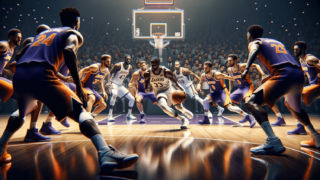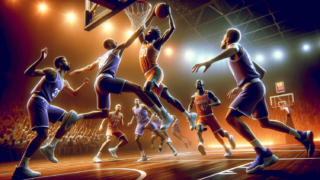
Ever watch an NBA game and see a player darting around the court, weaving through defenders, and scoring with ease, leaving you wondering how they got so open? Well, it’s time to uncover the secret behind one of the most effective off-ball maneuvers in basketball: the Curl Cut. In this fun and informative blog post, we’ll dissect the fundamental components of this strategic move, share tips on perfecting your curl cut, and showcase some of the greatest players who’ve become masters in the art of freeing themselves for a wide-open shot. So, grab your sneakers and get ready to elevate your hoops knowledge as we dive into the captivating world of the Curl Cut!
What’s a Curl Cut in Basketball?
A Curl Cut in basketball is an off-ball movement where a player runs towards and around a teammate to create separation from their defender. Upon reaching the teammate, known as the screener, the player changes direction and “curls” towards the basket for an open scoring opportunity. This strategic cut exploits defensive pressure and allows ball handlers to find open teammates with ease, facilitating better scoring opportunities and fluid offensive plays.
Breaking Down the Curl Cut
To truly understand the mechanics of the curl cut, let’s break down the play step by step. Remember, every player’s role is vital to its success:
- The set-up: To initiate the play, the player who will make the curl (the cutter) positions themselves on the court’s perimeter, preferably at the wing or the corner.
- Creating space: The cutter starts by taking a step or two away from the basket, slightly widening the gap between them and their defender.
- The screen: A teammate (the screener) positions themselves strategically between the cutter and the cutter’s defender, essentially putting their body in the way to deter any defensive movement.
- The curl action: The cutter swiftly moves around and brushes the screener, ideally staying within an arm’s distance. This move forces the defender to go over or under the screen, often resulting in a momentary lapse of coverage for the cutter.
- Receiving the pass: As the cutter makes their way to the basket, the ball-handler makes a timely pass to the now-open player in hopes of scoring an easy basket.
Key Elements for a Successful Curl Cut
For a curl cut to be effective, several critical factors need to be considered:
1. Timing
Timing is everything in basketball, and the curl cut is no exception. The cutter should make their move at just the right moment, catching their defender off-guard. Simultaneously, the ball-handler must make a swift and accurate pass, capitalizing on the split-second window provided by the screen.
2. Reading the defender
The cutter needs to read their defender’s position and actions accurately. Depending on the opponent’s movements, the cutter may need to alter their route slightly or even switch to a different cut entirely. Mastering this skill often takes time and experience on the basketball court.
3. Fluid movements
Speed and smoothness are crucial components for a successful curl cut. The cutter’s change of direction and overall movement should be fluid, allowing them to maintain explosiveness while minimizing the opportunity for the defender to recover.
4. Effective screen
The screener plays an equally important role in the curl cut. It’s vital that the screen is set firmly and legally to create the space needed for the cutter to get open. An inefficient screen will provide the defender with an easier route to navigate, negating the curl cut’s effectiveness.
Developing Your Curl Cut Skills
Now that we’ve delved into the fundamentals of the curl cut, let’s explore how you can incorporate this technique into your own basketball skillset:
1. Footwork and agility drills
Footwork is a critical aspect of the curl cut, and you can work on improving it anywhere, with or without a basketball. Agility ladder drills, for instance, are an excellent way to build quickness and coordination.
2. Practice reading defenders
Next time you’re playing pick-up basketball or in a team practice, pay close attention to your defender’s movements. The better you become at reading them, the more effective your curl cuts will be.
3. Master the stop-and-go
One area that often gets overlooked when working on curl cuts is the stop-and-go skill. Think of it as a stutter-step, where you slow down momentarily before exploding into the curl cut. This brief hesitation can catch defenders off-guard, providing an even wider opening for the cutter.
4. Practice with a partner or team
Nothing beats real-time practice with teammates or coaches. Learning how to set screens and execute a timely curl cut with a team can help you hone your skills while building chemistry with your fellow players.
Notable Curl Cut Masters
There have been many basketball greats who’ve mastered the art of the curl cut. Let’s take a look at a few who’ve left their mark on the game:
1. Reggie Miller
Hall of Famer and former Indiana Pacers star Reggie Miller was known for his exceptional off-ball movement and tireless work ethic. His ability to get open using the curl cut left defenders continually scrambling to keep up.
2. Ray Allen
Regarded as one of the most precise shooters in NBA history, Ray Allen also possessed an uncanny ability to escape his defender’s grasp utilizing the curl cut. His lightning-quick release and pinpoint accuracy were only further amplified by his mastery of maneuvering through screens.
3. Klay Thompson
One-half of the famed “Splash Brothers,” Klay Thompson has built a reputation not only for his shooting prowess but also his ability to move effortlessly without the ball. Thompson’s textbook curl cuts have undoubtedly helped establish the Golden State Warriors as a modern basketball dynasty.
Defending Against the Curl Cut
Of course, it’s important to recognize that while the curl cut is a potent offensive weapon, there are ways to defend against it:
1. Communication on defense
Defenders should communicate loudly and frequently about oncoming screens. This constant chatter will alert teammates to any impending curl cuts or other off-ball movements, allowing them to prepare and react accordingly.
2. Fighting through screens
Defenders should never assume the screen will stop them in their tracks. Instead, they must work to muscle through the screen, staying as close to the cutter as possible, minimizing the impact of the curl cut.
3. Switching on screens
In certain situations, defenders may need to switch assignments when a screen is set. This tactic can help eliminate the momentary lapse of coverage created by the curl cut, provided the defenders can communicate effectively during the switch.
4. Anticipation and positioning
Intelligent defenders who excel at reading offensive movements and anticipating cuts can position themselves accordingly. By doing so, they can effectively eliminate the cutter’s route to the basket and disrupt the curl cut’s success.
Expanding Your Basketball Knowledge
Mastering the curl cut is a valuable asset to any basketball player’s skillset. It’s an essential weapon in your offensive arsenal, one that only becomes more effective as you continue to sharpen your footwork, agility, and court awareness. For the smart defender, understanding how to shut down the curl cut is equally important. By practicing both aspects of the game, you’ll become a more complete player, ready to help your team on both ends of the court.
Utilizing Curl Cuts in Different Offenses
As a versatile maneuver, the curl cut can be integrated into various offensive systems. Understanding how it fits into these systems can help improve team play and individual performance. Below are a few offensive setups where the curl cut can shine.
1. Flex Offense
The flex offense relies on constant cutting, screening, and ball movement to keep the defense off balance. By incorporating the curl cut into the flex system, players can quickly and effectively exploit openings in the defense and generate high-quality shot opportunities.
2. Triangle Offense
Phil Jackson’s famous triangle offense places an emphasis on players’ positioning, off-ball movements, and well-timed cuts. The curl cut is a natural fit within this meticulous system, as it practically becomes an unstoppable force when executed with precision among the other moving parts.
3. Motion Offense
As its name implies, the motion offense thrives on continuous movement from all players on the court. The unscripted nature of this offense relies on players’ ability to read defenders and make opportune cuts. The curl cut can be highly effective in a motion offense, especially when combined with smart passing and good off-ball screens.
Incorporating the Curl Cut into Your Game
Now that you know how the curl cut works in various offensive systems, it’s time to focus on incorporating it into your game. Here are some tips to keep in mind:
1. Master the fundamentals
Start by getting comfortable with the basics of the curl cut: timing, positioning, and overall execution. Drill the movement regularly, and work on developing muscle memory for optimal performance on the court.
2. Watch and learn from the pros
Study film of skilled players like Reggie Miller, Ray Allen, and Klay Thompson, who have excelled at using the curl cut. Watching their movements, footwork, and overall game awareness can provide valuable insights to work on during your own basketball journey.
3. Experiment and adjust
Every player and team is unique. Your curl cut might not look exactly like a pro’s, but that’s okay. Experiment with different routes, speeds, and techniques until you find what works best for you within the context of your team’s offense.
Benefits of the Curl Cut
Adding the curl cut to your basketball toolkit provides numerous on-court benefits:
- Increased scoring opportunities: By consistently getting open, you can generate more shot opportunities for yourself and your team.
- Better off-ball movement: The skills required to execute the curl cut, such as footwork, speed, and agility, can significantly improve your overall off-ball capabilities.
- Heightened basketball IQ: Learning to read defenders and make timely cuts helps develop a deeper understanding of the game and increases your capability to contribute to your team’s success.
- Greater versatility: Being able to employ the curl cut in various offensive systems makes you a more adaptable and valuable player, capable of thriving in multiple scenarios and with different teams.
With practice, dedication, and a solid understanding of its mechanics, the curl cut can become an integral part of your basketball repertoire, helping you elevate your game and contribute significantly to your team’s success.
FAQ: Curl Cuts in Basketball
In case you still have questions or need more clarity on the concept of curl cuts in basketball, we’ve put together a comprehensive FAQ section. Here, you’ll find the answers to the most commonly asked questions, providing you with a deeper understanding of this strategic move.
1. Are curl cuts only for guards?
No, curl cuts can be utilized by players of all positions. Regardless of their position on the court, any player with good fundamentals, speed, and timing can take advantage of the curl cut to create scoring opportunities.
2. How can I practice curl cuts without teammates?
You can practice curl cuts individually by focusing on footwork, agility, and change of direction. Using an imaginary screen, work on exploding around the “screener” and cutting towards the basket. Repeating this movement will help develop muscle memory and hone this skill.
3. How is a curl cut different from a straight cut?
A curl cut involves changing direction and “curling” around a screener towards the basket. In contrast, a straight cut is a direct and linear movement from one point to another, typically used when trying to get open or move without the ball.
4. Can I use the curl cut in a zone defense?
Yes, the curl cut can be effective against a zone defense. By cutting quickly around a screener and moving into gaps within the zone, a skilled cutter can create openings and exploit the weaknesses of the defensive setup.
5. How important is a good screener in a successful curl cut?
A good screener is vital to the success of a curl cut. The screener’s body position, ability to set a solid and legal screen, and awareness of when to release the screen all play significant roles in creating separation between the cutter and their defender.
6. Why does my curl cut fail?
A curl cut may fail for several reasons, including poor execution, ill-timed or inaccurate passes, or strong defense. Identifying the specific issue and focusing on improvement in that area can help increase the probability of success during future curl cuts.
7. How can I improve my curl cut speed?
Improving your agility, footwork, and explosiveness through targeted exercises can help increase your curl cut speed. Consider strength training, plyometrics, and agility ladder drills to focus on these areas.
8. Do I need to use a curl cut every time I come off a screen?
No, the curl cut is just one of several options when coming off a screen. Depending on the situation, you may need to use a straight cut or a fade cut instead. Your ability to read defenders and react accordingly is crucial in deciding when to use each type of cut.
9. Can a curl cut be easily defended?
Like any move in basketball, the curl cut can be defended if the defense communicates well and anticipates the cutter’s actions. However, if executed properly and with precise timing, the curl cut can still create valuable scoring opportunities.
10. Does the curl cut work in pick-up basketball games?
Yes, the curl cut can be just as effective in pick-up basketball as it is in organized play. Similarly, enhancing your skills and understanding of when to use curl cuts can improve your overall performance in any basketball setting.
11. When should I use fake moves before executing a curl cut?
Using fake moves or changing pace shortly before executing a curl cut can help catch defenders off-guard and create increased separation. Experiment with stutter steps, hesitation moves, or change-of-direction feints in conjunction with curl cuts to maximize their impact.
12. Are there any NBA teams known for using curl cuts frequently?
While many NBA teams incorporate curl cuts into their offensive schemes, the Golden State Warriors and San Antonio Spurs have been particularly known for effectively utilizing curl cuts in recent years due to their expert off-ball movement and strong team chemistry.
13. How can I improve my ability to read the defense when executing a curl cut?
Improving your ability to read defense when executing a curl cut comes with experience and practice. Watch film, study your opponents during games, and work on reacting to defenders’ moves in pick-up and organized games to develop a deeper understanding of defensive movements and tendencies.
Featured Posts
- No pillar pages found.





